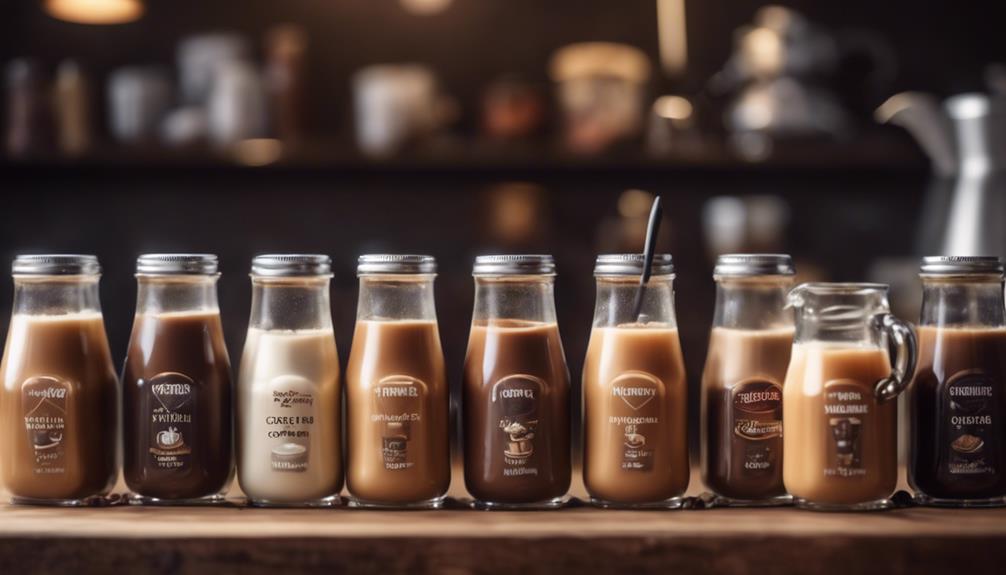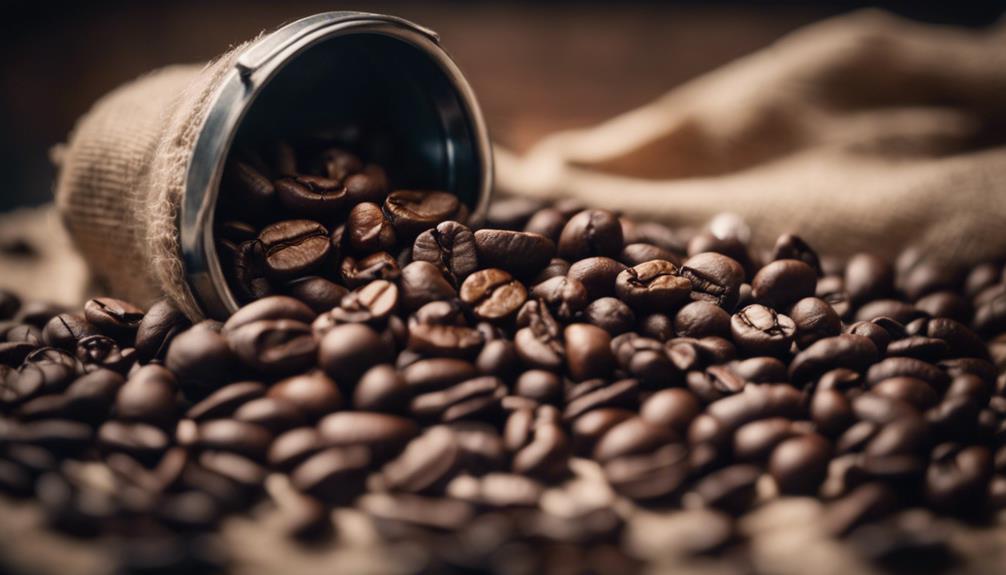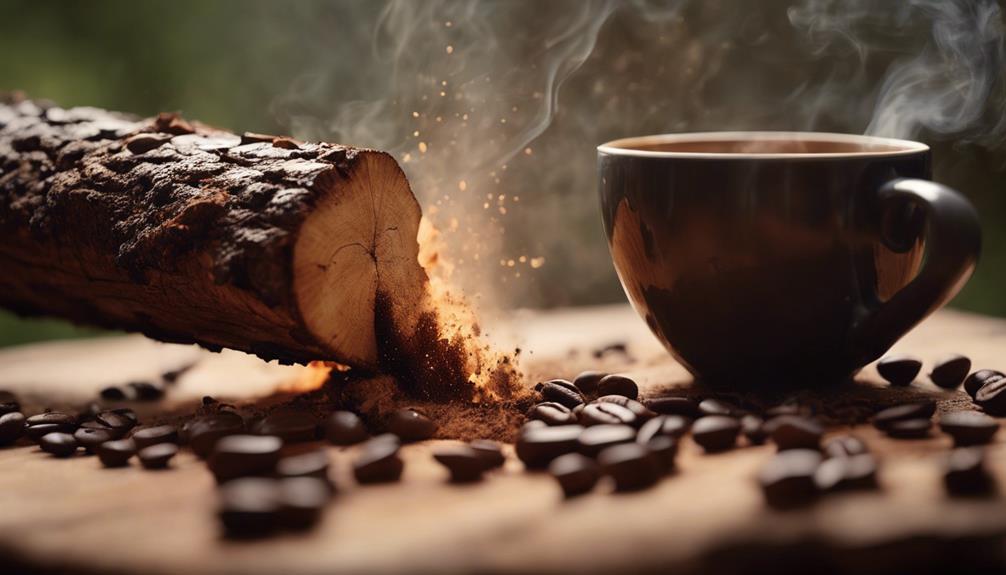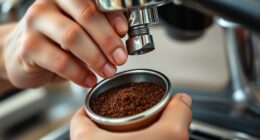Flavored coffee, whether from beans or grounds, typically contains minimal to no carbs. The flavoring oils used in the roasting process are responsible for this. They enhance taste without significantly altering nutritional content. Regular, light, and dark roast coffee beans have very few carbs. Sweeteners and creamers impact overall carb intake more. Flavored coffee beans may add to the calorie count due to added oils, not sugars. It is wise to check labels for specific nutritional details to make informed choices. Flavored coffee can be a low-calorie and carb-conscious option. For more information on flavored coffee nutrition, explore additional details in the researched information.
Key Takeaways
- Flavored coffee beans have minimal carbs due to added flavor oils.
- Pay attention to sweeteners for overall carb impact.
- Flavored coffee grounds are carb-conscious with no carbohydrates.
- Flavored coffee is typically free of carbs, sugars, and calories.
- Hidden carbs may be present in some flavored coffees.
Nutritional Value of Coffee Beans
Coffee beans offer a range of essential nutrients, including antioxidants, magnesium, potassium, and vitamins A and C.
When it comes to flavored coffee beans, the good news is that the added flavors don't markedly impact the carb content. Flavored coffee grounds derive their taste from concentrated flavoring oils, which don't contribute extra calories, carbs, or sugars to the brew.
These oils, whether natural or synthetic, are typically added before roasting using compounds like propylene glycol. As the coffee beans undergo the roasting process, the flavors are enhanced, influencing the overall taste and aroma of the coffee without substantially altering the nutritional profile.
While the flavoring may provide a delightful twist to your coffee experience, rest assured that the carb content remains relatively consistent, making flavored coffee beans a flavorful and nutritious choice for your daily cup of joe.
Carbs in Coffee Beans
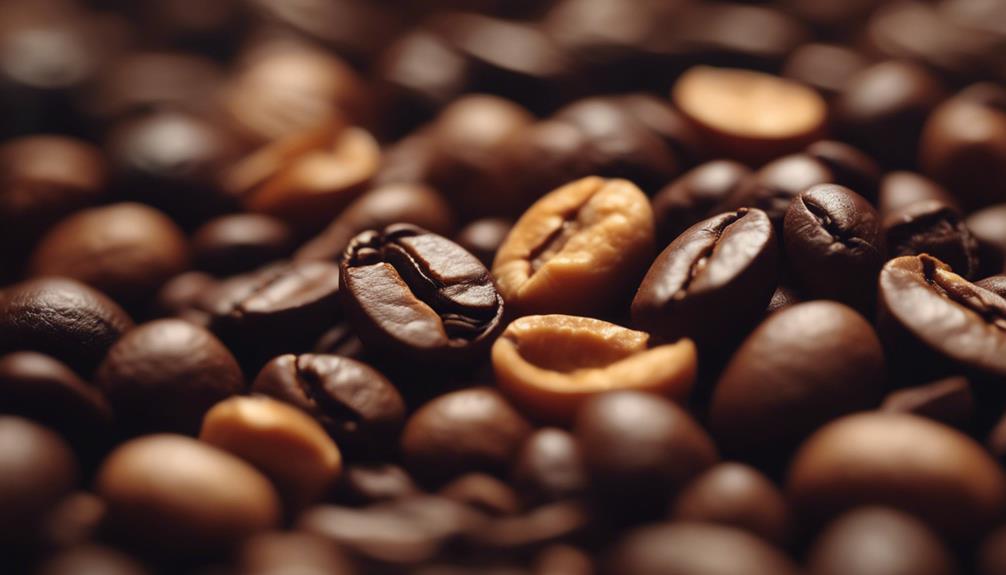
When evaluating the carb content of coffee beans, especially flavored varieties, it is important to take into account the impact of additives and oils used for flavoring. Flavored coffee beans, even though they are roasted, often derive their flavor without introducing significant carb content. The process of flavoring coffee beans typically involves the addition of oils and artificial flavorings, which do not contribute substantially to the carb count.
To illustrate the minimal carb content in flavored coffee beans, consider the following table:
| Coffee Bean Type | Carb Content |
|---|---|
| Regular Roasted | 0g |
| Flavored (e.g., Vanilla) | 0g |
| Artificially Flavored | 0g |
| Light Roast | 0g |
| Dark Roast | 0g |
As shown in the table, coffee beans, whether flavored or not, generally have negligible carb content, making them a suitable choice for those monitoring their carbohydrate intake. Remember to pay attention to any additional sweeteners or creamers when evaluating the overall carb impact of your flavored coffee.
Calories in Coffee Beans
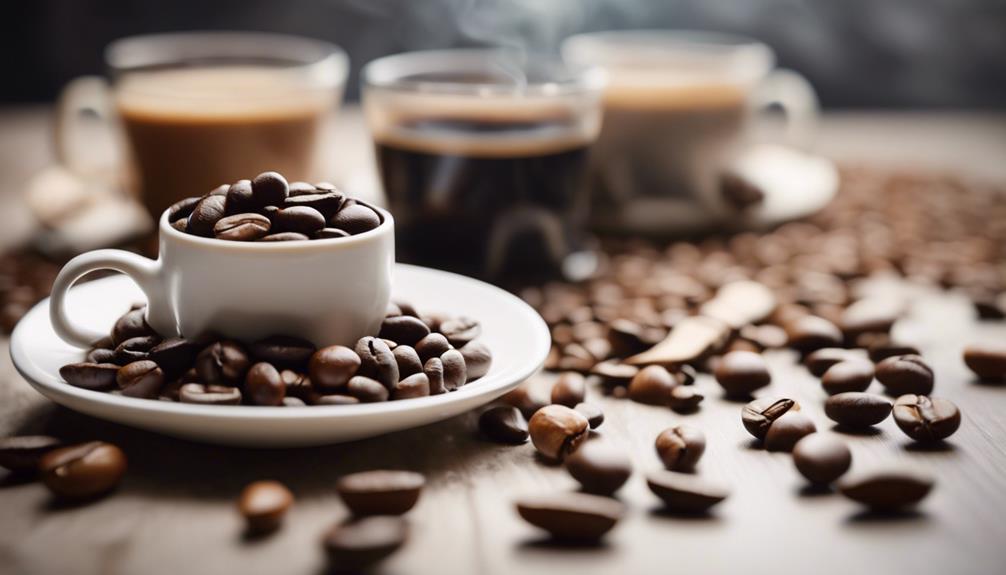
Coffee beans, the essential ingredient in your morning brew, pack a modest 2 calories per cup once brewed.
While flavored coffee beans generally steer clear of carbs, the added flavor oils contribute to the calorie count.
Keep an eye out for hidden sugars or carb-loaded additives that could sneak into your flavored coffee blend.
Coffee Bean Calories
When considering flavored coffee beans, it's important to note that the calorie content primarily comes from the natural composition of the beans themselves. Contrary to common misconceptions, flavored coffee beans typically don't add extra calories, carbs, or sugars.
The flavoring in these beans is often achieved through the use of concentrated oils, not additional sugars. Hence, the calorie content in flavored coffee primarily stems from the oils present in the beans used for flavoring, rather than from added sugars.
This means that flavored coffee can be a low-calorie option if consumed without additional sweeteners. So, when enjoying your flavored coffee, you can appreciate the taste without worrying about a significant increase in calorie intake.
Carb Content Comparison
When examining the carb content of flavored coffee, it's crucial to take into account the additional ingredients used to create the flavor profile.
Nutrition labels in the US are required to list sugar content, which is often minimal in flavored coffee due to the use of artificial flavors.
The calorie content in flavored coffee primarily stems from oils and extracts, not carbohydrates.
As a result, flavored coffee can be a low-calorie option if consumed without added sugars or creamers.
Flavored Coffee Grounds

Flavored coffee grounds are a carb-conscious choice for coffee lovers. When comparing carb content, these grounds typically contain no carbohydrates due to the flavoring process using extracts and oils.
Popular flavor options offer a variety of choices without adding extra carbs to your brew.
Carb Content Comparison
When comparing the carb content of different flavored coffee grounds, one must take into account the additives and ingredients used in the flavoring process. Flavored coffee grounds typically contain minimal to no carbs as the flavors are derived from additives, extracts, and oils rather than carbohydrates. Below is a comparison table showcasing the carb content of various popular flavored coffee grounds:
| Flavored Coffee | Carb Content (per 8 oz) | Low-Carb Option |
|---|---|---|
| Vanilla | 0g | Yes |
| Hazelnut | 0g | Yes |
| Caramel | 0g | Yes |
| Mocha | 0g | Yes |
| Pumpkin Spice | 0g | Yes |
These flavored coffee options are ideal for individuals following low-carb or keto diets as they provide variety without adding unwanted carbohydrates. When brewed, flavored coffee typically remains carb-free, making it a versatile and enjoyable choice for those looking to control their carb intake while still indulging in delicious flavors.
Popular Flavor Options
Among the popular flavor options for flavored coffee grounds are cinnamon swirl, French vanilla, pecan praline, and salted caramel. These flavors are achieved through the addition of artificial flavoring blends to the coffee beans post-roasting. Different coffee companies use a variety of methods to infuse their beans with these enticing flavors, resulting in a diverse range of options for consumers to enjoy.
French vanilla is a beloved choice among flavored coffee enthusiasts, offering a creamy and smooth taste profile. The use of artificial flavoring in French vanilla coffee beans guarantees a consistent and long-lasting flavor experience. Coffee companies carefully select and blend these artificial flavorings to deliver the rich essence of vanilla with every sip.
When exploring the world of flavored coffee grounds, it's fascinating to learn how the art of artificial flavoring enhances the coffee-drinking experience. By understanding the meticulous process behind creating flavors like French vanilla, consumers can appreciate the skill and innovation that coffee companies employ to craft their signature blends.
Nutritional Value in Flavored Coffee Grounds

The nutritional content of flavored coffee grounds is minimal, typically free of carbs, sugar, and calories. The flavors in flavored coffee come from concentrated extracts and oils, rather than from added sugars or carbohydrates. Artificially flavored coffee beans may contain chemicals like propylene glycol for taste, but these do not contribute significantly to the carb or calorie content. It's essential to always check the labels of flavored coffee products for specific nutritional information. Below is a table summarizing the nutritional value of flavored coffee grounds:
| Nutrient | Amount per Serving |
|---|---|
| Carbs | 0g |
| Sugar | 0g |
| Calories | 0 |
Enjoy your flavored coffee guilt-free, as it is a low-calorie and carb-free option to add some excitement to your daily brew.
Reduce Calories in Coffee

To reduce calories in your coffee, opt for unsweetened versions and steer clear of high-calorie creamers or syrups. By choosing black coffee or adding a splash of low-fat milk, you can enjoy your daily cup with fewer calories. If you're on a high-fat diet or looking to manage your calorie intake, avoiding sugary additives is essential. Artificial sweeteners can be a suitable alternative for those seeking a touch of sweetness without the added calories.
When selecting flavored coffee, be mindful of the sugar content in different brands, as these levels can vary greatly. Opting for artificially flavored coffee can provide the taste you desire without the extra carbs, making it a low-calorie option. Checking the nutritional information online for specific brands can help you make informed choices that align with your dietary preferences and goals.
Final Thoughts

Consideration of the overall impact of flavored coffee consumption is important before making your final decision on incorporating it into your daily routine.
While non-flavored coffee is a safe bet for those closely monitoring their carb intake, flavored coffee can be a tricky terrain. It's key to remember that the flavors in these beans often come from artificial flavoring, which typically doesn't add significant carbs. However, if you're on a strict ketogenic diet or aiming to minimize carb intake, it's vital to be cautious.
Some flavored coffees may contain hidden carbs in the form of sweeteners or creamers. To make sure you're making an informed choice, always check the nutritional information on the specific brand of flavored coffee you're considering.
Opting for sugar-free options and being mindful of any additional carbs you might be adding can help you enjoy your flavored coffee while staying within your dietary goals. Keep in mind that artificial extracts are commonly used to flavor coffee beans, offering taste without a significant carb impact.
Frequently Asked Questions
Is There Sugar in Flavored Coffee?
In flavored coffee, the presence of sugar varies based on the specific brand or type of flavoring used. While flavored coffee beans themselves don't inherently contain sugar, some flavorings may have added sugars.
To make sure you're consuming a sugar-free option, it's important to check the ingredients and nutrition labels. Opting for unsweetened flavored coffee or those with artificial flavorings can be a low-carb alternative.
Always verify for added sugars to make an informed choice.
Do Flavored Coffee Pods Have Carbs?
Flavored coffee pods typically contain minimal to no carbs as the flavoring is often derived from extracts or oils rather than added sugars. It's essential to check the nutrition label or the manufacturer's website for specific carb information.
Artificial flavors in coffee pods don't contribute to carb content. Enjoy these pods as a low-carb option without compromising taste.
What Coffee Has No Carbs?
When you're looking for coffee with no carbs, opt for black coffee, including unsweetened flavored varieties. These options typically contain zero carbs and are low in calories.
Artificially flavored coffee beans are also a good choice as they provide flavor without adding carbs. Always check the nutritional information of flavored coffees, as some may contain added sugars or carby additives.
When unsure, refer to specific brand information online to determine the carb content accurately.
Is Flavored Coffee Allowed While Fasting?
When fasting, you can enjoy flavored coffee without carbs if it's unsweetened. Flavors come from extracts and oils, not sugar.
Artificial flavorings in coffee don't add carbs. Always verify labels for hidden sugars.
Stay guilt-free savoring flavored coffee during fasting if it aligns with your diet. Just make sure it's sugar-free to avoid breaking your fast.
Does Flavored Coffee with Caffeine Contain Carbs?
Yes, flavored coffee with caffeine can contain carbs, depending on the specific flavoring or additives used. It’s important to check the nutrition label for carb content. If you’re in need of a pick-me-up, consider trying liven alkaline coffee caffeine content for a tasty and energizing option.
Conclusion
To wrap up, flavored coffee doesn't necessarily have carbs. While some flavored coffee grounds may contain added sugars or sweeteners, the actual coffee beans themselves are carb-free.
It's important to be mindful of the ingredients in flavored coffee products to make sure you aren't consuming unnecessary calories. By choosing wisely and opting for natural flavors, you can enjoy a delicious cup of coffee without the added carbs.
Remember, knowledge is power when it comes to your daily caffeine fix.
